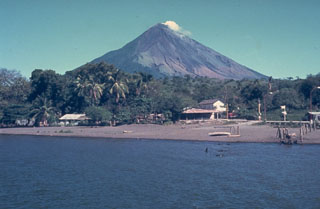Report on Concepcion (Nicaragua) — April 1978
Scientific Event Alert Network Bulletin, vol. 3, no. 4 (April 1978)
Managing Editor: David Squires.
Concepcion (Nicaragua) Strong ash eruptions in late March
Please cite this report as:
Global Volcanism Program, 1978. Report on Concepcion (Nicaragua) (Squires, D., ed.). Scientific Event Alert Network Bulletin, 3:4. Smithsonian Institution. https://doi.org/10.5479/si.GVP.SEAN197804-344120
Concepcion
Nicaragua
11.538°N, 85.622°W; summit elev. 1700 m
All times are local (unless otherwise noted)
The newspaper La Prensa reports that strong ash eruptions from Concepción began in late March. Ashfall made life "intolerable" for persons living near the volcano, and was reported as far away as Belén, on the Pacific Coast 28 km SW of Concepción.
Geological Summary. Volcán Concepción is one of Nicaragua's highest and most active volcanoes. The symmetrical basaltic-to-dacitic stratovolcano forms the NW half of the dumbbell-shaped island of Ometepe in Lake Nicaragua and is connected to neighboring Madera volcano by a narrow isthmus. A steep-walled summit crater is 250 m deep and has a higher western rim. N-S-trending fractures on the flanks have produced chains of spatter cones, cinder cones, lava domes, and maars located on the NW, NE, SE, and southern sides extending in some cases down to Lake Nicaragua. Concepción was constructed above a basement of lake sediments, and the modern cone grew above a largely buried caldera, a small remnant of which forms a break in slope about halfway up the N flank. Frequent explosive eruptions during the past half century have increased the height of the summit significantly above that shown on current topographic maps and have kept the upper part of the volcano unvegetated.
Information Contacts: La Prensa; D. de Jerez, Parque Nacional Volcán Masaya.

